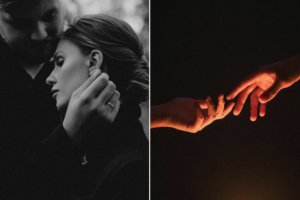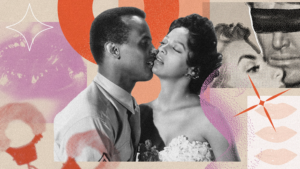If you’ve ever fired up the old internet machine and typed ‘relationship stages’ into Google, you’ll realise that, for the most part, no two articles seem to agree on what the stages of a relationship actually are. stages, or how many even exist. Well, we’re shooting for the sky at EliteSingles, so we’re diving into academia and looking for an expert duo who have worked to develop one of the most respected theories about the different stages of a relationship.
Knapp’s Relational Development Model is a well-documented theory about the stages of a relationship and is the brainchild of communication scholar Mark L. Knapp. In the model, Knapp divided the average couple’s journey into two phases containing five stages. The two phases are ‘Coming Together’ and the somewhat less pleasant ‘Coming Apart’, and together they trace the trajectory of the relationship from beginning to (possible) end. The stages are as follows:
The ‘bonding’ phase
Getting Started – First impressions are made in less than 15 seconds. This is when we show the best of ourselves. We look intensely at the other person to get to know them. Physical appearance plays an important role.
Experimentation – This is a period of increased self-disclosure, where we begin to learn from each other. Small talk leads to finding things in common. Most relationships in life will not progress beyond this stage; think of ‘cooler’ office relationships.
Stepping Up – We determine if mutual affection/attachment exists through deeper conversations and frequent one-on-one contact. At this stage, we undergo “secret tests” to see if the relationship will prosper. These can include going public as a couple, being apart for an extended period of time, jealousy, opinions from friends, and either partner having a difficult time outside of the relationship. Of course, this period can be disturbing.
Integration – Belongings/friends/household are shared, and similar dress/behaviours are adopted. In today’s world, social networks can play a role, for example, a couple can appear in each other’s profile photos. The couple is exclusive to each other, with each other’s secrets, sexual behaviors, and future plans revealed.
Bonding – This usually occurs in the form of marriage or another method of showing the world that you are a team and that your relationship is truly intimate. Once this stage is reached, many couples remain linked forever.

The ‘separation’ phase
Differentiating – The couple disconnects. Differences are emphasised and similarities are eroded, leading to conflict. This may be the result of joining too fast. However, this is an expected stage of any relationship and can be resolved by giving each other space.
Circumscribe – This is a breakdown in communication, during which expressions of love diminish.
Stagnation – One or both parties feel trapped. Problems don’t arise because the partners already know how the other will respond. It is still possible to revive the relationship, but many simply stay together to avoid the pain of ending a relationship.
Avoidance – Partners ignore each other and avoid frequent contact, leading to a less personal relationship and gradual emotional detachment.
Termination
One or both partners are dissatisfied, unhappy and the relationship must end. The reasons for this may be physical separation or simply drifting apart as time goes on.
So, at first glance, Knapp’s theory of relationship stages seems to explain the usual patterns that couples go through when mating – think of the blissful ‘honeymoon’ period and the huge and powerful emotions that are conveyed. while we fall in love .
In order to further open up the theory and have a good stir inside, EliteSingles contacted two co-authors of the original book containing the stages. Dr. Anita Vangelisti is a professor at the University of Texas specialising in interpersonal communication, and Dr. John Caughlin is a professor of interpersonal communication in close relationships at the University of Illinois. Together, they shed some light on one of the most famous role models of the relationship stages.
In Knapp’s model, at what stage does a relationship go from platonic to romantic, or can this happen at any point in the progression?
Vangelisti: You would expect a transition from platonic to romantic to be more likely during the escalation or integration stages, but it could happen during any stage. For example, two people might meet (start a friendship) and, once they get to the experimentation stage, discover that they are interested in more than friendship.
Are all stages of Knapp’s model inevitable, or can relationships skip any of these stages?
Caughlin: Model sequencing occurs for a variety of reasons, including the fact that “each stage contains important presuppositions for the next stage.” But people can skip stages or mess them up. For example, I’ve heard stories of people who quickly get started and experiment and then head straight to the altar, think Las Vegas weddings.
As the model suggests, skipping those steps is a “bet on the uncertainties presented by the lack of information that could have been learned in the skipped step.” That doesn’t mean the relationship will inevitably break down, but it’s a risky move. flirtwith.com
Can the stages be repeated indefinitely?
Vangelisti: Yes, the stages can be repeated over and over again. However, it is important to know that each time couples go back and “repeat” a stage, their experience will be different than before. They will bring back old experiences, a set of memories and new ideas when they go through that stage again.
Caughlin: Changing one’s Facebook status to “in a relationship” says something different about the couple than changing it to “in a relationship” the first time.
Do you think it is beneficial for couples looking for a happy relationship to know the model?
Caughlin: It can be useful for a number of reasons. For example, it can help understand why the partner engages in certain behaviours, which can be helpful in helping understand the meaning of those behaviours.
Vangelisti: However, it’s important to keep in mind that partners can over-analyze their relationship. Sometimes one partner says something mean to another because he had a bad day, and the mean comment doesn’t indicate anything negative about the relationship. It is important to remember that patterns of behaviour tend to be more significant than individual behaviours.
At what stage of the “bonding” phase, if any, do most romantic relationships tend to struggle or end?
Caughlin: I don’t think it’s correct to say that “most” romantic relationships struggle at some point in time. However, research on “relationship turbulence” has shown. That many couples experience a turbulent period in which they decide whether to move from casual dating to a more committed relationship. This can be an intense time in a relationship with a lot of emotion (both positive and negative), and it’s a time when some couples will decide not to continue and others will calm down. This period of turbulence roughly corresponds to the transition between intensification and integration.
Vangelisti: But I think it’s important to keep in mind that individual couples may struggle at different stages for different reasons. So, for example, a person who is very, very shy may have trouble with the initiation stage. But will be fine once they get to the escalation stage. In general, people who have high self-esteem and positive. Trusting relationship experiences will have fewer difficulties. Than those with low self-esteem and more negative, unpredictable relationship experiences. flirtwith
Since its inception, has the nature of how romantic relationships are formed changed?
Vangelisti: The way relationships are formed has certainly changed over time. The example that probably comes to mind for most people is the increased frequency with. Which partners initiate relationships online rather than face-to-face. In this case, while the channel people use to initiate their relationships has changed, the behaviours they engage in have not changed as much.
People still take the time to “get to know” each other, and research shows that most relationships started online move offline pretty quickly if they’re going to progress.
Is a ‘happily ever after’ possible in Knapp’s model?
Vangelisti: People often think that “happily ever after” means that the happy couple never disagree, never get upset, and never doubt their relationship. Knapp’s model suggests that even happy couples experience ups and downs in their relationships. What matters is how they handle those ups and downs. The ability, and the will, to get through down times together is what makes relationships work.
Caughlin: If that’s asking if a couple can be in the bonding stage for a long time and both partners report. That they’re happy, then sure, that happens. But happily ever after doesn’t happen. If one means that in the Hollywood love story sense. Where the end of the movie is the wedding and the couple is supposed to be happily ever after.
Realistically, most couples will experience at least some elements of breaking up. At different times. Being happily ever after is not an achievement, but rather requires communication practices that continue to foster happiness.
RELATED ARTICLE: THE ULTIMATE GUIDE TO DATING KIDS
Vangelisti: Do you work together to get through tough times? Do you respect each other enough to listen to each other, even when you disagree? Are you willing to overlook the annoyances because you know that your partner’s positive qualities outweigh their annoying habits? Can you talk about your doubts and solve them together? The ability, and the will, to get through down times together is what makes relationships work.
So there you have it friends. A brief look at the theory behind the various stages of a relationship tells us. That a successful and happy relationship. That lasts a lifetime is entirely possible as long as both parties. Are willing to provide a little patience and understanding. What if you are looking for the perfect partner to start. The journey of a lifetime? Take the first step by completing the personality test on EliteSingles!



